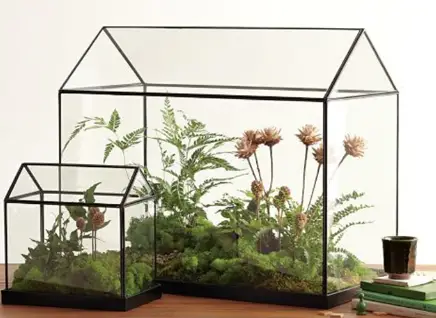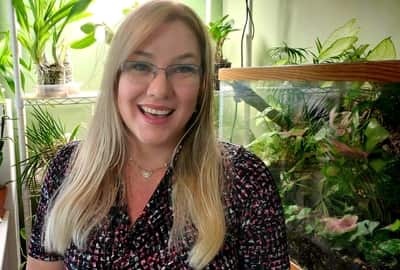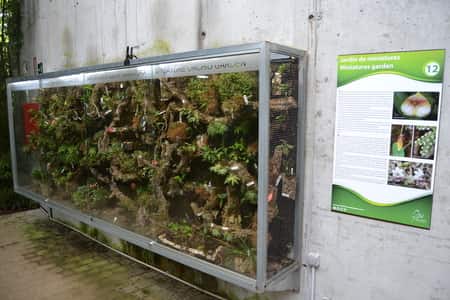Some of the many pleasures of cultivating orchids is displaying them in floral arrangements, mounting them on driftwood or tree bark, or making a terrarium. The last one is my favorite. To make an orchid terrarium, you need to first pick the right orchid vase.
The type of vase you decide to use will influence what orchids can be planted and how you are going to maintain it.

Orchid vases for terrariums are split into three categories:
fishbowl vases (or open-mouthed vases),
Wardian cases,
and terrariums.
The last can be further categorized into open and closed terrariums.
Let’s look at each of these three categories to better decide which orchid vase is best for your needs.
1. Open-Mouthed Orchid Vases
If you’re a beginner and have never planted a terrarium before, the open fishbowl type vase is a great place to start. It’s good to have the liberty to fix something, if by chance you made the soil too damp or not humid enough.
With the open top glass vase, you can easily modify, adapt, and tweak to achieve the best environment for your orchid.
This is also the most budget-friendly option, since fish-bowl type vases are easily found in floral shops and glass stores. Even an old glass flower vase works.Open-mouthed vases are also called
open terrariums.
Some orchid enthusiasts resist calling these vases terrariums, because they are just a vase…nothing special. But to contrast these with a closed terrarium, where no outside air can enter, the classification stands.

If you have an old aquarium laying around (R.I.P. little goldfish) that is a great place to start. You’ll need to wash it out thoroughly, scrubbing the nicks and crannies of each angle to really get any potential bacteria and microorganism out. It would even be a great idea to bleach it down, to make sure you have eliminated any excess harm or potential threat to your orchids.
In the open-mouthed-vases, you can place them in the sun, but just remember that the glass will magnify the heat and sun rays. So I don’t recommend it, even though other orchid growers have done this. I’ve personally never had success with a glass vase on the window sill. If your orchid is a cool-growing orchid, don’t place it on the window sill or near direct sunlight.
This is not necessarily a bad thing, because you can place the glass vase anywhere else in the house that receives bright light for a good portion of the day: living room, home office, kitchen, etc…
Even though a lot of pictures have orchids in the bathroom, I don’t recommend it, unless you keep the bathroom lights on 12 hours a day. Usually bathrooms are way too dark for orchids, even the low-light ones.
2. Wardian Cases
Wardian Cases are the intermediate level orchid vases. These create a closed environment, but are not totally air tight. They are made more as a design piece to be used on a living room end table than a proper growing habitat for your orchids. But they do have their own charm.
A little history behind the Wardian Cases: The name, Wardian Case, was attributed by the London surgeon in 1833 who designed these cases: Dr. Nathaniel Bagshaw Ward. Like most successful things in life, the Wardian case started off as an experiment gone wrong.
Dr. Ward was trying to grow butterflies (actually it was a moth) inside a closed vase with soil and a few plants. We never learned what happened to the moth, but it looks like the experiment failed.

Dr. Ward pushed his glass closing to the side, giving up on it. A few weeks later he returned to see that a beautiful fern had grown inside the vase.
This was so unusual because the London air was so thick and polluted, sometimes called Pea-Soup fog, that no ferns could grow. Yet inside this closed container, the air had maintained clean.Dr. Ward started experimenting with other plants, with a high success rate. Since he traveled often to other countries, he had a hobby of bringing back to London species he would find overseas.
In his journal he said that nineteen out of twenty plants would die on the six-week boat trip. On one of these journeys, he took the Wardian case, and plant survival rate inverted: nineteen out of twenty plants survived.
This discovery was an open door for plant trade, since now tropical plants could be shipped back and forth on ships. Coincidentally, orchid trade to England more than exploded after the Wardian Case was made known to the public.
As for today, they are more decorative than functional. If you have had success with an open-mouthed, fish-bowl vase, then this is the next step. The idea to is to keep this vase closed for a week, up to two weeks, then only opening it to heavily mist the plants.
You can find Wardian cases in most floral design shops and décor stores. You’ll have to adapt it a little to make it purely functional, and not rust or leak. Once you find a Wardian case you like, that matches your style of décor, check the sides. You can add a water-proof sealant to the bottom and sides.
3. Orchid Terrariums or Closed Terrariums
The last category of orchid vases is a closed terrarium. There are many, many types of terrariums, and you can start with a budget of less than one hundred dollars and climb quickly from there.
The easiest/cheapest is the open terrariums, which don’t differ from the open-mouthed vases, mentioned above.
Terrariums are a sealed unit where no outside air can enter the “atmosphere” and none can leave. This is perfect for recreating different types of natural habitats, because basically who controls the humidity, light, temperature, and watering, is…you. You get to design and create a landscape adding special features that can be as simple as driftwood and as complex as a waterfall, dripping into a small pond.How do terrariums work?
The air moisture is trapped into a confined spaced. As the temperature rises during the day, the water evaporates from the soil and travels up, to the top of the closed container. Hitting the glass, it condenses, and drips back down to the soil at night. The constant humidity is controlled, and doesn’t ever fluctuate.

That is why it’s easier to grow high-humidity orchids in terrariums. I could never get my humidity higher than 59% in my home office, and that’s with a humidifier and a pebble tray, or humidity tray.
Quick Tip: If you’re looking for a humidifier, then check out these. This article is the by-product of an extensive search for plant humidifiers for indoor environments. I wrote it when I was searching online for a small humidifier for my home office, where I keep my orchid collection. After researching hundreds. literally hundreds, of different brand-names and models: ultrasonic, cool-mist, warm-air, wick, and many others… I picked out the top four runner-ups and wrote about which one I chose.
Back to terrariums… For a long time, the high humidity orchids were off my list of cultivating. But with terrariums, which traps the humidity inside, you can control how high the humidity needs to be.

Some terrariums, built more for animal habitats, called vivariums, come with grow lights, fans, and all the “cool adaptations” that really increment orchid growth.
Of course, you can dish out more money than you’d like, but take a look at them and paste a picture of them on your desk: next year’s goal. 😊 If you’re wondering which orchids grow best inside terrariums, check out this article I wrote for 5 of the best closed terrarium orchids, which all happen to be miniature orchids. If those 5 didn’t melt your heart, I included a list of 10 more orchids, which aren’t mini’s, that also thrive in closed terrariums. So please, check that article out.
Don’t Stop Learning!
If you want to be included in more information and get a 14-page fertilization guide, please sign up for my newsletter. I don’t spam, but send emails out bi-monthly with some curious topics of interest. If you want more information, click here to go to a specific page on this website where I explain it more in detail.

Also, if you are looking for an orchid journal to keep your notes specifically about orchid care, check out my 2 solutions for that on this page. If note-keeping isn’t your thing, then there is a free excel spreadsheet that you can download. Click here for more information on how to do that.
If you subscribe to my newsletter, I will send you a 14-page guide on the main tips of orchid fertilizer. It is downloadable and you can print it out on your computer. I designed the guide to double up as a coloring book, just to make it fun.
Want some pictures to inspire you? If you head over to my Pinterest page , I have many ideas of open terrariums
, I have many ideas of open terrariums , Wardian cases, and closed terrariums
, Wardian cases, and closed terrariums , with ever growing number of pins.
, with ever growing number of pins.
I post these ideas so you can get inspired, hopefully finding one or two pictures that really move you to start building your terrarium today, whether it be open-vased, Wardian case, or closed terrariums. I hope this article has helped with a few tips and ideas for how to select the right vase for your orchid, and what to keep in mind when selecting orchids for each vase.
Please leave a comment in the section below, so we can reach out and get in touch.
Happy Cultivating!


Thank you! I enjoy your posts and find your information
very helpful for keeping my orchids happy.